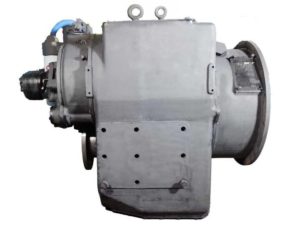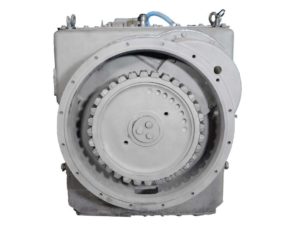This comprehensive FAQ guide for the Twin Disc MG-540 marine transmission addresses the most common troubleshooting concerns, startup protocols, maintenance procedures, part sourcing tips, and performance optimization questions. Whether you’re operating a tugboat, commercial trawler, or offshore supply vessel, these FAQs offer technical clarity and field-proven advice to help keep your gear running strong.
Troubleshooting, Startup, Maintenance, and Part Sourcing
1. What should I check first when the MG-540 fails to engage?
Start with hydraulic pressure. Verify the main pressure is 226–265 psi and that the EC050 (if equipped) is receiving power. LED indicators will guide you to solenoid or voltage issues.
2. Why is my clutch slipping during heavy loads?
Most likely causes are worn friction plates, improper oil pressure, or contaminated oil. Rebuild with a fresh clutch kit and replace oil and filters.
3. What pressure should I see at idle?
You should see 226–265 psi on the main system and 27–78 psi on the lube system, depending on the ratio and RPM.
4. Can I switch from mechanical to EC050 control?
Yes. You’ll need to replace the mechanical valve with a GP valve, install the EC050 module, and wire the system according to the Twin Disc diagrams.
5. What are the LED codes on the EC050 for solenoids A and B?
Green = Cruise, Red = Troll, Flashing Red = Coil fault. If both solenoids are red, the module may be corrupted and needs replacement.
6. How do I test solenoid resistance?
Use a multimeter. Each solenoid should measure 7–10 ohms. The speed sensor should read around 4600 ohms.
7. Where is the best place to install a pressure test kit?
Use the pressure ports on the control valve for forward, reverse, and neutral pressure. The digital transducer kit (BOM 42168) is ideal.
8. When should I perform a full overhaul?
Every 5,000 operating hours or if experiencing repeated slippage, low pressure, or heavy vibration.
9. What’s the most common failure requiring rebuild?
Burnt clutch packs due to overheating or low oil pressure.
10. What’s included in a rebuild kit?
Friction plates, steel plates, bearings, shaft seals, gaskets, o-rings, snap rings, and installation shims.
11. Do I need special tools for reassembly?
Yes. Tools like the clutch spring compressor, bearing installers, and seal drivers are required.
12. What oil should I use?
Use SAE 30 or 40 non-detergent mineral oil or a marine-rated hydraulic fluid like TO-2.
13. How often should oil be changed?
Every 1,000 hours or six months—whichever comes first. Sooner in heavy-duty environments.
14. How do I change direction of rotation?
Rotate both oil pumps 180°, reposition the air baffle, and update the nameplate to reflect the BOM change.
15. Where can I get replacement parts?
Diesel Pro Power offers premium aftermarket kits. Twin Disc parts are also available via authorized distributors.
Compatibility With Different Vessel Types
16. Can the MG-540 be used on both port and starboard engines?
Yes. It can be driven from either direction and reversed by changing which clutch is engaged.
17. Is this model suitable for tugboats?
Absolutely. The MG-540 is specifically built for high-torque, continuous-duty applications like tugboats and offshore supply vessels.
18. What about fishing trawlers?
Yes. With appropriate clutch kits and cooling configuration, it performs reliably under trawling loads.
19. Can the MG-540 be used on sailboats?
Only with proper trailing pump or shaft brake installation to prevent damage from windmilling).
20. Does it work with both raw and fresh water coolers?
Yes. Twin Disc offers both exchanger types (XB1618G for raw, XB1618H for fresh water).
Signs of Worn Clutches, Oil Contamination, or Valve Failure
21. How can I tell my clutches are worn?
You’ll experience longer engagement times, slipping under load, or a noticeable drop in oil pressure during shifts.
22. How does oil contamination show up?
Discolored or foamy oil, loss of pressure, or oil leaks. Check for water ingress or clutch dust buildup.
23. What does valve failure look like in EC050 systems?
Failure to shift, flashing red LEDs, or inability to maintain troll/cruise control.
24. Can a bad breather cause issues?
Yes. A clogged breather can overpressurize the housing and cause seal blowouts.
25. Is noise always a sign of failure?
Not always—but whining at steady RPM or clunking on shift could mean worn gears or failing bearings.
Operation and Startup Protocols
26. Should I prime the system before first start?
Yes. Turn the engine over without starting or use a trailing pump to circulate oil first.
27. What’s the correct idle speed for engagement?
Idle speed should be 600–700 RPM, with no shifting above 1800 RPM.
28. What oil pressure do I need before shifting?
At least 226 psi in the main circuit, 27–78 psi in the lube circuit depending on RPM and ratio1.
29. How do I check alignment during reinstallation?
Use a feeler gauge at 90° intervals on the output flange. Target ≤ 0.002” runout.
30. Do I need to calibrate troll mode after install?
Yes. Run Cruise mode for 20+ seconds to allow the EC050 to learn shaft speed before engaging Troll.
Service, Rebuilds, and Maintenance Logistics
31. How long does a full rebuild take?
A trained tech can complete the job in 8–12 hours if all tools and parts are available.
32. Can I rebuild the transmission in the vessel?
Yes, depending on access. Major assemblies like shafts and clutches can be serviced in-boat.
33. How often should I inspect shaft seals?
Every 100 hours. Lubricate with water pump grease if zerk fittings are present.
34. When do I need to replace zinc rods in heat exchangers?
Every 90 days. Replace if more than 50% depleted.
35. What if I have a different BOM than the manual?
Cross-check your BOM with Diesel Pro Power or a Twin Disc dealer to ensure correct parts selection.
Sourcing Kits and Aftermarket Options
36. Are aftermarket kits reliable?
Yes—when sourced from trusted providers like Diesel Pro Power, they meet or exceed OEM specs.
37. Are kits available for specific BOMs?
Absolutely. Each clutch, seal, and gasket kit is tailored to BOM and gear ratio.
38. Can I buy just a friction pack?
Yes. Clutch plate renewal kits are sold individually or as part of full overhaul kits.
39. Do you offer rebuilt MG-540 units?
Yes. Rebuilt gears are available and tested to OEM pressure specs. Ideal for minimizing downtime.
40. What comes in a full overhaul kit?
Clutches, steels, bearings, gaskets, seals, o-rings, snap rings, and adjustment shims.
EC050 and Control System Questions
41. What happens if EC050 loses power?
Transmission will default to neutral. No pressure = no clutch engagement.
42. Can I program EC050 myself?
Basic mode calibration can be done via troll switch and ignition cycles. Advanced reprogramming requires Twin Disc software.
43. Is EC050 waterproof?
It is water-resistant but not fully submersible. Mount in a dry location.
44. Can I test EC050 on the bench?
Yes. With a 12V power supply and potentiometer, you can test LEDs and simulate shifts.
45. What if I lose one solenoid?
You’ll lose either forward or reverse depending on the coil. The system may stay in neutral or fault to safe mode.
Performance Optimization and Field Repairs
46. How can I reduce shift shock?
Make sure the pressure rise curve in Cruise mode is programmed correctly. Calibrate with the EC050 profile module.
47. What’s the best oil for hot climates?
SAE 40 non-detergent oil or premium TO-2-rated hydraulic fluid to handle heat.
48. Can I reuse steel plates if they look clean?
Only if flatness and thickness are still within spec and no glazing or pitting is present.
49. How do I detect water in the oil?
Milky appearance, steam from breather, and elevated oil level are strong indicators.
50. Where can I get technical support?
Contact Diesel Pro Power or an authorized Twin Disc distributor. Provide your BOM and serial number for the fastest assistance.
Videos About Twin Disc Transmissions
6 Reasons Your Twin Disc Transmission Has Low Oil Pressure
7 Reasons Your Twin Disc Transmission Is Overheating
3 Reasons Your Clutch Plates in Your Twin Disc Transmission Are Making Excessive Noise
Bull Gear On A Twin Disc Transmission
Rebuilt Twin Disc Transmissions



 Free US Calls: 1-888-433-4735
Free US Calls: 1-888-433-4735 International: 305-545-5588
International: 305-545-5588


